Living with Drought
It’s no secret that much of Montana is dry. Montanans, on average, make do with less than 15” of precipitation per year. This means, for many communities across the state, there’s not a lot of wiggle room in terms of moisture. A shortage of even a few inches of rain or snow at the wrong time can turn the drought map red. And no community is immune. Even in the Northwest, amid the influence of Pacific weather patterns that spawn cedar groves and monster trout, drought can take root like an unwelcome weed.
Yet, Montanans are a hardy, adaptable lot and have successfully lived with drought for over 150 years. Indigenous communities, too, have practiced ecosystem management and drought adaptation for millennia prior. Today, many tribal communities across the state continue to model impressive climate and drought adaptation planning, programs, and projects that incorporate science, culture and historical practices, and traditional knowledge.
Just as drought impacts differ across Montana’s ecosystems and communities, so do drought adaptation strategies. The right strategy for one community may not be right for another. Community resources and capacity, local leadership, cultural considerations, primary water uses, and many other variables determine which adaptation strategies can best address diverse local needs.
Just take a look
- Big Sky, Big Water
- The Benefits of Biochar
- Traditional Knowledge Informs Climate Science and Adaptation
- Rising Trout Help to Raise Awareness
- Seeding the Future
- Real Cowboys, Virtual Fencing
- Simple Structures Lead to Healthier Streams

Climate change and warmer, shorter winters pose an obvious threat to the ski industry of North America, and Montana is no different. While Big Sky Resort in the Gallatin River valley south of Bozeman has the advantage of being the highest elevation resort in Montana with consistent snowfall, there’s no avoiding the shorter winters. Like other historically ski-oriented operations, Big Sky has been developing summer programs with mountain biking as the centerpiece to take advantage of longer summers and lift-access terrain.
But the pressures on Big Sky go beyond a diminished snowpack and fewer powder days. And the solutions to adapt a business and a community to the changing climate require more than a shift to summer sports. Big Sky, like many mountain towns in the west, has seen explosive growth since COVID and the ensuing Zoom economy sent urban professionals running to the hills. Increased water demands stemming from new development, a need for artificial snow making, and a growing population, also threaten the sustainability of the town. Steps being taken by Big Sky Resort and the surrounding community could offer insights into how ski towns can adapt to shorter winters and heightened pressure on water resources.
Reusing wastewater is a critical part of the water efficiency equation in Big Sky, both because of limited holding capacity for the cleaned wastewater, and as a way to minimize withdrawal demands on the aquifer. The current wastewater treatment facility was built in 2004, and town growth was outpacing the facility’s capacity by the 2010s. A local non-profit, the Gallatin River Task Force, convened 35 stakeholders (state agencies, local developers, the water and sewer district, etc.) to collaborate on a planning document for community sustainability. One of the plan’s core recommendations was to upgrade the wastewater treatment facility.
At some point you could hit a crossroad where you can’t provide more capacity for new development.
Big Sky is now in the process of a $48 million improvement project. The new plant would increase capacity and upgrade wastewater discharge from Class A to Class A-1 standards, meaning the reused water would be clean enough for snow making, industrial use, and aquifer recharge.
Ron Edwards has been working with the Big Sky Water and Sewer District since 1995, back when there were no meters in the much quieter canyon community. Adapting to fast-paced growth and warmer, drier weather has been a multi-faceted effort.
“Even though our visitation numbers have gone up, we’ve seen our demand drop over the last five years in Mountain Village,” Edwards says. “I attribute that to a few things. We replaced old service lines and we improved our water metering, creating four tiers of rates – the more you use, the more you pay. There’s a correlation with rate setting and driving people to conserve water.”
The town’s economic engine and largest water user, Big Sky Resort, has been reusing its treated wastewater since the resort opened 45 years ago. All of its wastewater is reused for irrigation and golf course management, and the sludge produced from the wastewater treatment is mixed with sawdust and wood chips to create a compost that’s sold locally. Recently, the resort has implemented efficiency upgrades throughout its lodging and employee housing units. In their Golden Eagle employee housing unit water use declined 20% following the efficiency upgrades.
It’s tricky to find the balance between smart growth (more housing, more facilities, more revenue built to high-efficiency standards) and sustainable water use in a hydrologic setting dependent on groundwater supplied by snow. But drought conditions the last couple of years remind everyone of the realities facing a growing ski-mountain biking town.
“We’re not planners. We’re not zoners,” says Edwards. “At some point you could hit a crossroad where you can’t provide more capacity for new development.”
But for now, Edwards hopes to implement a rate program that increases water rates when the state agency declares drought, a practice that has seen success in California’s Cucamonga District.
that increases water rates when the state agency declares drought, a practice that has seen success in California’s Cucamonga District.
Snow making is the next big hurdle for Big Sky Resort. Climate change means more snow making, and currently the resort taps into a surface water reservoir.
If the ski resort can eventually reuse the upgraded wastewater facility’s Class A-1 water it could pose an interesting scenario that might be a win-win.
“If we can reuse wastewater in the winter it would get us away from all this summer storage and open disposal options that run through winter months,” says Edwards. “That’s a game changer for my operation making it much easier to manage more water, and it creates a water recharge scenario— the snow-making would essentially store water on the ski slopes as snow that would melt into recharge in the spring.”
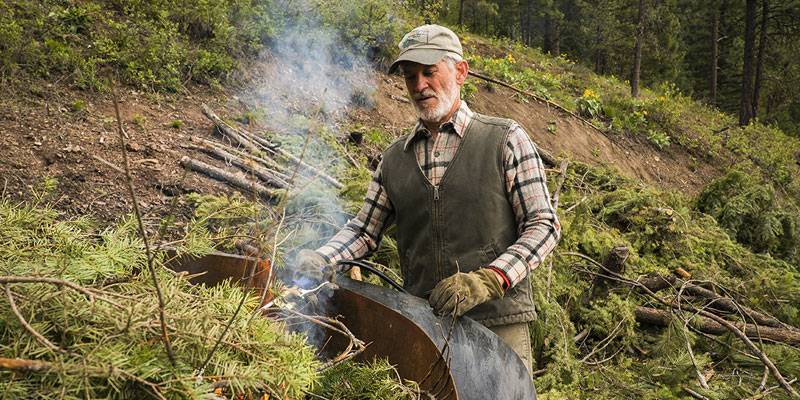
It’s a perfect day for burning. The wet, cool spring of 2022 continues in the Blackfoot Valley with a high of 50 degrees, overcast skies, and a promise of evening rain. Yesterday, Dave Atkins, a retired Forest Ecologist with the U.S. Forest Service, and a few volunteers strung cable around thinned pines and firs and winched the small logs down steep slopes covered in young grasses, Indian paintbrush, larkspur and balsam. Today the slash pile sits beside a double-ringed metal circle that looks and acts like an oversized campfire ring. The wood will be methodically burned in the ring and then extinguished to create “biochar,” a new term for a simple, ancient practice that could be another tool to enhance water retention in soils and sequester carbon.
Biochar is the charcoal-like product created from pyrolysis—burning organic matter in the absence of oxygen. A typical open fire of organic matter burns down to ash, an oxidative process in which almost all the carbon in the organic material volatizes as carbon dioxide released into the atmosphere. Burning without oxygen sequesters most of the carbon in the char and creates a porous material with a complex, convoluted structure ideal for water and nutrient retention when spread on gardens, crop fields or forests.
The amount of carbon stored in the soil far exceeds the carbon found above the earth’s surface, so the idea of utilizing soil to sequester carbon offers a promising adaptation to climate change. But in typical fuel reduction efforts in U.S. forests, the thinned timber is burned to ash in large piles. It’s an easy and inexpensive way to eliminate the debris, but one that releases the wood’s stored carbon into the atmosphere.
“Pile burning is a total waste of that material so if you can use it one way or another, let’s use it,” says Dr. Tom DeLuca, Dean of Forestry Ecosystems & Society at Oregon State University, and one of the leading researchers on biochar’s implications for soils.
“Our prairies used to burn every 1-5 years so that char was incorporated into the soils frequently for thousands of years,” DeLuca explains. “Biochar is a natural part of soil ecosystems that we’ve eliminated so there’s no reason to not apply it if it’s available and not too expensive to access.”
Barry Dutton, a retired soil scientist, has been consulting with the Blackfoot Challenge for 13 years. The Challenge is an organization seeking to coordinate efforts to conserve and enhance the natural resources of the Blackfoot watershed, of which Atkins' land is a part. Dutton is working with The Nature Conservancy (TNC), Bureau of Land Management, U.S. Forest Service, and the University of Montana on a study of applied biochar on Blackfoot Valley soils.
Biochar is a natural part of soil ecosystems that we’ve eliminated so there’s no reason to not apply it if it’s available and not too expensive to access.
“I am interested in biochar for three main reasons,” Dutton says. “As a soil amendment to increase water and nutrient holding capacity, as a way to reduce air pollution from slash burning and as a way to sequester carbon. In terms of drought concerns for irrigated agriculture, increasing soil water holding capacity can let us put on more water more quickly. This can increase the time between irrigations and reduce the number of irrigations per season.”
For Atkins, the biochar process is simple. The oversized fire ring, or kiln, is five stakes and two sets of five metal panels screwed together with a five-inch gap between the walls. He seals the metal ring’s base with dirt so oxygen isn’t drawn in from the bottom. He loads the ring with wood, ideally larger 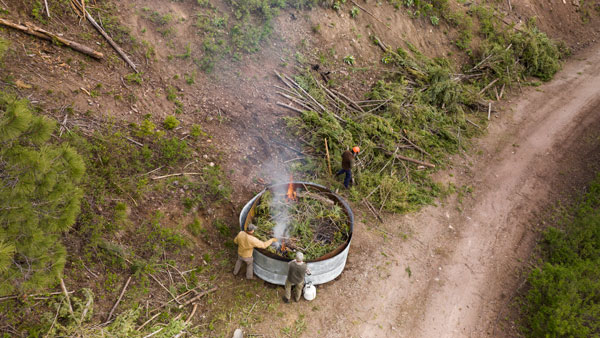 pieces at the bottom in a horizontal matrix, and adds wood as the fire burns down. The goal is an evenly packed bed of fuel that burns mostly in the lower half of the four-foot-high kiln. Once the flames have dissipated and the fire burns in an evenly distributed red-hot blaze, Atkins methodically extinguishes the fire, thus capturing the carbon in the charcoal wood before its released into the atmosphere.
pieces at the bottom in a horizontal matrix, and adds wood as the fire burns down. The goal is an evenly packed bed of fuel that burns mostly in the lower half of the four-foot-high kiln. Once the flames have dissipated and the fire burns in an evenly distributed red-hot blaze, Atkins methodically extinguishes the fire, thus capturing the carbon in the charcoal wood before its released into the atmosphere.
As Atkins extinguishes the last of the slash pile in a steamy haze, a light rain starts to fall on the Blackfoot Valley. Atkins unscrews the metal panels and the jet-black logs spread on the ground, charred time capsules of carbon. There’s nothing new to pyrogenic organic burning, but Atkins and others hope to revitalize the ancient practice and let biochar become an engine of carbon sequestration in forestry and a tool for drought resiliency in agriculture. For now, Atkins will continue preaching the benefits of biochar at the local farmers market and using his forest to store carbon for the next thousand years.

When Blackfeet people say they are of the land, it is not hyperbole. It is a statement of cultural reality. The landscape, the animals, the water, the soil, the weather, the people . . . all one.
“We’ve had this relationship for generations,” says Latrice Tatsey, Cultural Ecologist with the Piikani Lodge Health Institute, when we meet with a team working on the Blackfeet Climate Change Adaptation Plan on a snowy December morning in the Blackfeet Environmental Office in Browning.
“Western thinking is very linear,” adds Helen Augare-Carlson, Blackfeet Community College Institutional Development Title III Director. “Our thinking is cyclical and holistic.”
Everything about the climate plan speaks to this connection between landscape and culture, and to the interwoven nature of the effort: referencing ceremonies and the wisdom of elders, incorporating education about climate change in school curriculum, dove-tailing with other conservation efforts on the reservation, listening to and observing the people and the land before taking action.
Climate issues connect K-12 students to ancient wisdom while it primes them to become stewards of the land.
Using beaver mimicry on local streams is a case in point. Beaver dam analogs have become a key strategy in the effort to conserve water, build soils, recharge groundwater, and retain streamflows in watersheds that have suffered from the impact of climate change.
“This is not a new concept,” says Gerald Wagner, Director of the Blackfeet Environmental Office. “We pay attention to animals. We observe them and communicate with them and learn.”
What the Blackfeet have learned from observing beavers has led to the construction of small dams on streams, built from local materials – pine posts, willow branches, sod – to strategically contain water in ponds that help mitigate the impacts of drought and retain flows in dewatered streams.
Local school students are helping build and monitor the projects, plugging leaks, photographing from monitoring points, wrapping trees, sampling and measuring water and soils. Early results are promising – streams flow longer, ground water storage has increased, and wetland habitat is rebounding.
K-12 students are exposed to climate issues through field trips, partnerships with landowners, camps, and language immersion sessions that connect them to ancient wisdom while it primes them to become stewards of the land going forward.
The 800-acre Blackfeet Community College campus and the local high school grounds provide valuable laboratory testing sites for climate change projects, 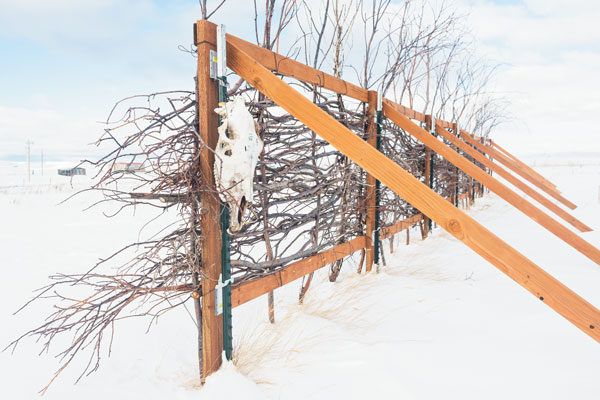 including a greenhouse, solar panels, snow-fencing and stream restoration. In the process, young people learn about climate related challenges and take part in implementing measures to address them.
including a greenhouse, solar panels, snow-fencing and stream restoration. In the process, young people learn about climate related challenges and take part in implementing measures to address them.
In a field next to a high school parking lot, a set of snow fences are being tested to capture snowdrifts in selected spots that will collect meltwater and recharge aquifers, add moisture to the soil, and increase forage. A variety of fencing materials, from orange plastic to woven willow, are being used to assess effectiveness. From the looks of it, the woven willow is proving to be the most efficient material with the largest drift behind it. Cameras in set locations document the seasonal record of these snowdrifts and soil moisture is carefully measured.
The same principle applies on the larger landscape. “We use citizen scientists and local landowners to create the plan for their property,” says Edmo. Who better to rely on than the stewards who have lived on the landscape, observing seasons and the evolution of changes for decades and in some cases, for many generations? They know where the winds come from, where the streams dry up, how the vegetation and wildlife has adapted over time.
We use citizen scientists and local landowners to create the plan for their property.
Intensive regenerative grazing practices, for example, are an outgrowth of the traditional grazing regimes of herds of bison that once migrated across this same landscape by the millions. “That is how this land developed and evolved,” says Augare-Carlson.
For the Blackfeet, the relationship with landscape extends back to a time before international boundaries, to a time when bison thundered across the prairie in teeming herds, to a culture with intimate ties and ceremonies to honor every aspect of the environment. Over centuries, they have watched their territory shrink, their people become entangled with western values and habits, and their cultural bond with the land grow more tenuous.
“People throw around the word ‘resilience’,” says Tatsey. “That resilience starts with sustaining your own community, sustaining your culture.”
“We were privileged to grow up in this culture,” says Edmo. “Now it’s our job to keep translating that forward for future generations through our traditional history and through science.”
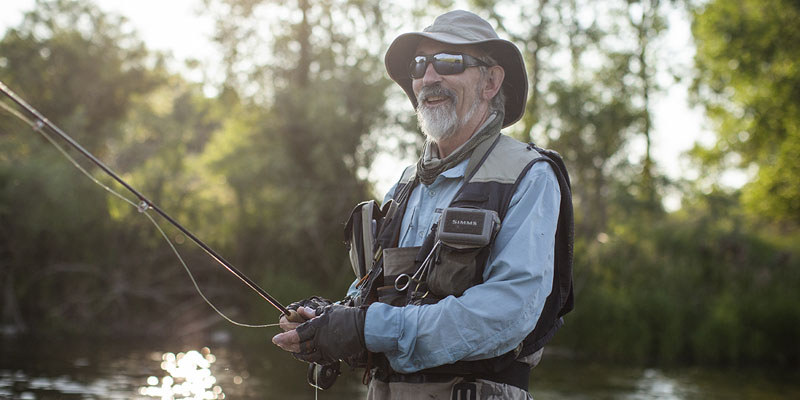
“The spinners are floating down that wrinkle,” Brant Oswald says aloud, either to himself, me, or just the river, in general. He deftly lifts his line from the water, casually back-casts then drops it onto the dark surface. His hand-tied spinner fly lands above the wrinkle and twirls, just before the smooth, blunt jaw of an 18-inch brown trout shatters the surface.
Oswald has seen a lot on the water. He began as a guide and instructor with Orvis (then Mel Krieger) before establishing his own guiding service based in Livingston in the early 90s. He’s published articles on fly fishing and served on the board of the Fishing Outfitter’s Association of Montana (FOAM) and on the Governor’s Upper Yellowstone Task Force. Montana fly fishing has been good to him, but Brant’s been around long enough to read the wrinkles.
For Oswald and other guides, leading people to fish in Montana has always involved more than knowing the honey holes and landing trophies. State regulations, private land access, and mitigating for over-crowding make up a matrix of considerations. The ongoing drought and increasing temperatures have added another layer of complexity: “Hoot Owl Closures.”
The hoot owl restrictions, an early 1900s moniker that refers to the early morning hours when loggers would hear owls hooting, are meant to limit stresses on fish by restricting fishing to the coolest hours of midnight to 2pm. Guides and their clients have had to adjust as these closures have become more frequent, widespread and enduring.
There’s an urgency now. The water supply issue affects all of us and we all have to apply those concepts of conservation to the rivers.
The fixed dates clients have been long accustomed to aren’t practical or effective considering earlier snowpack melt, warmer summer temperatures, and droughts. Earlier snowpack runoff might mean certain rivers fish better in the spring, but there’s always the chance for a late-spring flood event like the Yellowstone experienced in 2022. Mike Bias, Executive Director of FOAM and an outfitter himself, says there are almost no guides pushing August trips on the Big Hole River. They now aim for April, despite the risk of foul weather.
A socioeconomic resilience study projects that drought and warming waters could result in a spending decline in recreational activity of 64% in southwestern Montana rivers such as the Yellowstone, Madison, Big Hole, and Bitterroot by 2040 (Cline et al., 2022). This change is due to the fishing industry abandoning the area as waters warm and the trout migrate or disappear. Adaptation for the recreation industry starts with client messaging about how those impacts translate into lower stream flows, higher water temperatures, and other impacts that kill fish and ultimately change their vacations.
A few years ago Oswald read an article in Trout Unlimited that challenged guides to step up and be better educators around river stewardship. Clients from around the world come to Montana and they look up to guides for river knowledge. Oswald realized he and fellow guides have an obligation and an opportunity to be as informed as possible, especially in light of the threats posed by droughts, climate change, and the accompanying regulations. He and other veteran 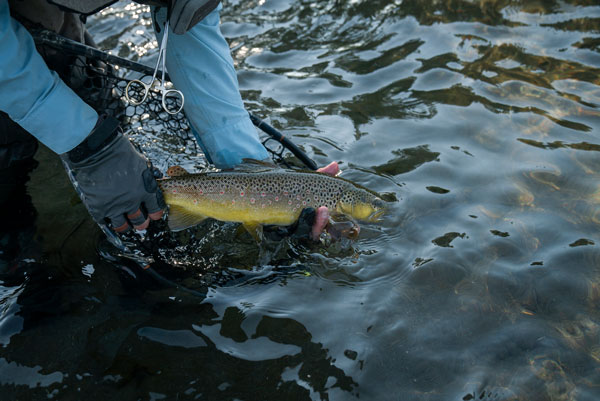 guides including Bias and the FOAM organization created a program—Guiding for the Future (G4F)—that would help educate guides on hydrological, ecological, agricultural, and social issues that impact Montana fisheries.
guides including Bias and the FOAM organization created a program—Guiding for the Future (G4F)—that would help educate guides on hydrological, ecological, agricultural, and social issues that impact Montana fisheries.
"As a guide you have two people in your boat for 8 hours,” says Bias. “That’s 20-30 people per week for 30 weeks. There’s a lot of misinformation out there. If the guides know the background of conservation and physiology, that’s a lot of influence we can have with the general public.”
Oswald and G4F had their first training course in 2019 with 25 guides. COVID halted their progress for two years, but the disruption motivated the G4F team to create a hybrid model of online and field classes. Now G4F can reach a larger audience at a lower cost. It might seem like a small thing, but as any fisherman knows, access is critical to success and the client-guide relationship offers its own access point for sharing perspectives and raising awareness about climate issues.
“There’s an urgency now,” says Bias. “We had more hoot owl closures last year than any other year before. It’s awareness. It’s shared sacrifice. The water supply issue affects all of us and we all have to apply those concepts of conservation to the rivers.”
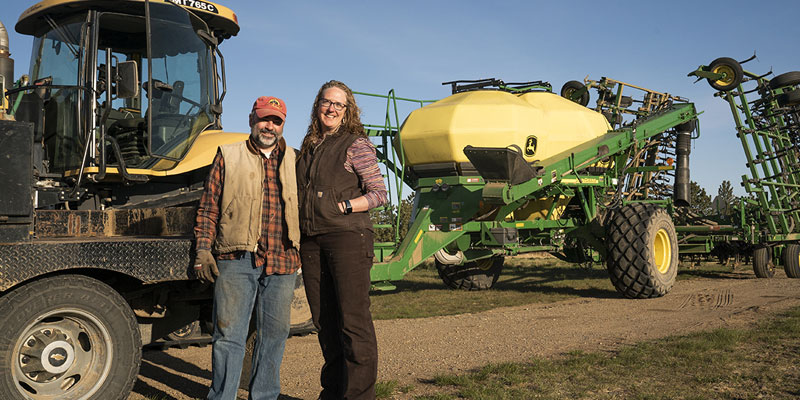
Doug Crabtree hit the snooze button this morning and he wishes he hadn’t. It’s Wednesday in mid-May and there’s still roughly 3,200 acres to seed. The sun, in a cloudless sky, is already well above the distant horizon. There’s an urgency as Doug and Jack, a long-haired Jack Russell settle into the air seeder cab. 30 acres of barley seeds remain in the tank, enough for one mile-long strip of dirt. Few things in the world make the air crackle with hope like a farmer dropping seed into bone-dry soil with a 75% chance of rain.
The scale here, even for Montana, is disorienting. The tower of an abandoned border-patrol radio base looms like a lighthouse 15 miles east. You can see a few neighbors, their tree-lined houses and grain bins make patches on the rolling tan carpet of mostly conventional wheat. At night you can hear a mouse breathe.
Crabtree and his wife Anna Jones-Crabtree own Vilicus Farms, an organic dryland crop farm in Hill County, about three miles from Canada. They started the farm in 2009 with the belief that dryland, rotational, organic farming can be viable on a large-scale.
“We’re an island of biodiversity in an ocean of earth,” Anna likes to say.
“My dad farmed about 4,000 acres in Ohio,” Doug says. “He supported our project out here but he never understood the diversity of it—the idea of living with weeds. I’m not sure he understood what we were doing, but he knew why we were doing it. Organic farming is something you first have to believe in as a better way. It’s certainly not easier.”
My hope is that we can identify new opportunities or plant some seeds that will help shift the whole system. And, yeah, I hope it actually rains tomorrow.
Tilling and rotation are the secret to Vilicus’ ambitious large-scale organic operation, but the tilling practice is fraught with controversy. Tilling too much or too deep can result in vital topsoil being blown away and exposes more soil to drying and ultimately compaction. At Vilicus, they take tilling very seriously with the intention of mimicking the historical impacts of large ungulates like elk, deer, antelope and bison on the soil. Tilling is also the only way they can control weeds without using herbicides. If successful, they’ve created a competitive advantage for seeds versus weeds, while avoiding chemical inputs.
“At the root of organic farming is the belief that we must feed the soil, not the plant,” Doug says as the seeder locks into its GPS track. “To do that, you have to learn the art of tillage.”
Of Montana’s 59 million acres of agriculture, less than 1% (351,000) is in organic production. Doug and Anna want to change that. It’s a daunting task. Even adding another 1% is a scale well beyond their capacity, but they hope to act as a proof point in how organic can be done. To them, re-learning how to grow food and seed by replicating, in a controlled way, natural processes is a critical adaptation as the climate changes. Most synthetic fertilizers and herbicides are derived from petrochemical products that contribute to global warming and can be an unpredictable cost for the farm (not to mention the health concerns over their use on food). Doug and Anna farm organically because 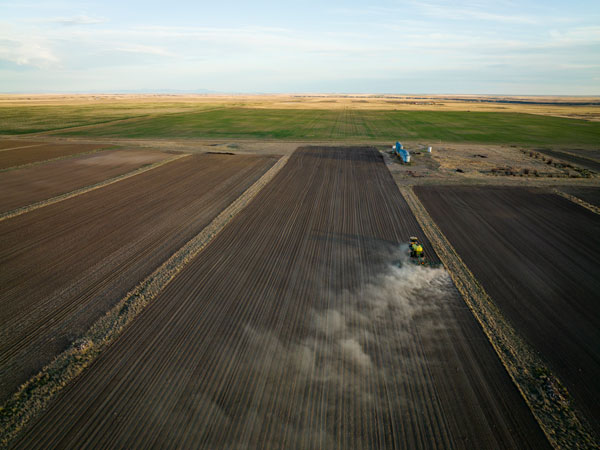 they believe in it, but also as a way to establish proven methods for food and seed production and offer real-world experience to young farmers wanting to create their own organic farms.
they believe in it, but also as a way to establish proven methods for food and seed production and offer real-world experience to young farmers wanting to create their own organic farms.
“You're not going to go flip a switch and suddenly have all organic agriculture,” Anna says. “So what's our transition? What are the steps we can take right now that set us up for success and faster progress later?”
“My hope is that we can identify new opportunities or plant some seeds that will help shift the whole system toward organic because that's the thing that’ll help us respond, adapt and be flexible to whatever happens with the climate. And, yeah, I hope it actually rains tomorrow.”
For now, Doug needs to get this seed in the ground. As the rumbling seeder drops barley specs into the dusty soil, he admits that they sometimes wonder if annual dryland farming is viable. The alternative out here would be a return to perennial grazing with cattle or bison. That would mark a massive loss for large-scale food and seed production needed to feed the world’s population.
“We’re always observing, learning, incorporating or eliminating,” he says. “We started with five-crop rotations, which I thought was radical, and now we’re at seven-crop rotations. Almost everything we do is experimental and the elephant in the room is the climate changing beneath our feet, or above our head, as it were.”
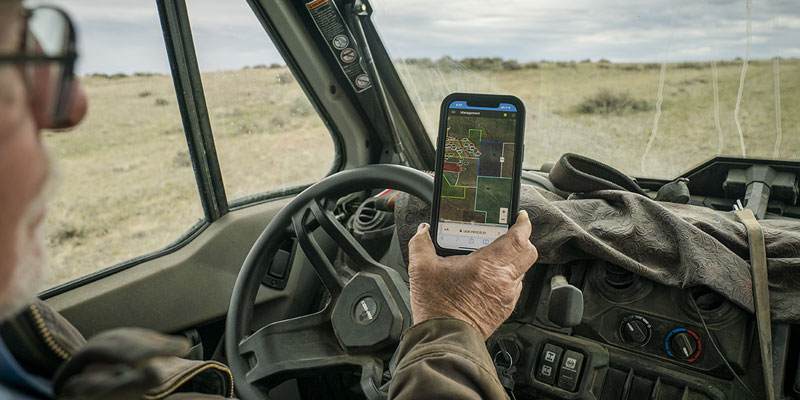
The house of Leo and Darla Barthelmess sits like an islet in the sea of sage 30 miles east of Malta, MT. A garage and small addition adjoin the original structure built of stones plucked from this arid, rocky land. Inside, Leo, 67, sits at the kitchen table with a mug of black coffee and an iPad, the tool he needs to move his virtual fences, keep tabs on his 450 cattle and, ultimately, maintain a thriving ranch.
“I can build a fence right here on my iPad,” he says. “The programming that I implement goes to Vence, the virtual fencing company in San Diego. And whatever magic they work means I can control the herd and better manage the grasses without having to build and maintain actual fences.”
Barthelmess moved with his parents to this ranch in 1964. He and his brother raise cattle on 25,000 acres of private, federal, and state land amidst one of the largest contiguous grasslands in North America. For almost 60 years Barthelmess and his family, like every other rancher in the west, used hardwire fencing to delineate pastures and manage grass and water resources. It’s worked, but Leo understands the need to adapt: steel prices have doubled recently and drought and warming temperatures have forced him to drill two wells as once reliable reservoirs diminish to mud holes. When your capital is not only your cattle, but the natural grasses they eat, there’s always the fear of over-grazing.
I can control the herd and better manage the grasses without having to build and maintain actual fences.
Leo switches to his iPhone and zooms into a map where a few dozen black cow icons appear against the brown topography of Pasture 21. We head outside and climb into Leo’s side-by-side. A coiled rope hangs behind my seat. Despite the radio collars, cell signals, and San Diego software engineers, this remains a large, dynamic ranch, and Barthelmess is still a cowboy. We drive out onto the range.
Barthelmess is running a pilot program with Vence. The company has proven success in warmer climates and wanted to test their equipment and software on the frigid northern Montana plains. Government grants and a willingness to experiment afforded Barthelmess the opportunity to shift to the virtual fencing. Each of the five repeater stations on the ranch offer a six-mile radius so the radio signals cover the entire ranch and most of the neighboring ranches.
“The amount of temporary or permanent fence you'd have to put in to move the cattle in the optimal way is an astronomical cost and the amount of work is significant,” Barthelmess says. “The virtual fencing allows the arid regions to participate in intensive soil and grass management.”
Managing cattle and pasture for intensive, concentrated grazing provides more time for the soil to transfer nutrients to the grasses during recovery periods. The combination of cattle hooves, manure, and longer recovery times fosters the growth of healthy soil microbes. Healthier soils act as a “carbon sponge” that absorbs more rainwater while also storing carbon rather than releasing it to the atmosphere.
“We have huge migratory movement through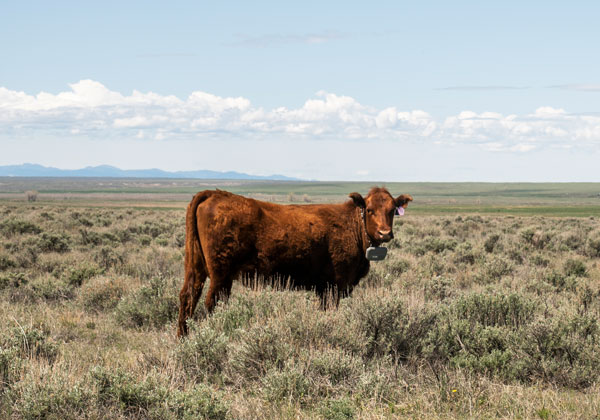 this region: antelope, mule deer, and sage grouse. And so that's another reason reduce the miles of barbed wire fences. It’s not that any one thing in itself is reason to do the virtual fencing, but all of it combined—the grazing management, the livestock management, the wildlife movements—is a tremendous reason to do what you can.”
this region: antelope, mule deer, and sage grouse. And so that's another reason reduce the miles of barbed wire fences. It’s not that any one thing in itself is reason to do the virtual fencing, but all of it combined—the grazing management, the livestock management, the wildlife movements—is a tremendous reason to do what you can.”
For now, due in large part to the drought, residual grass storage is shrinking more quickly than Leo would like. Ideally, the ranch would support its cattle on pasture for all 12 months, but the reality usually involves relying on trucked-in (and increasingly expensive) hay during the 1-2 lean months. With the control of virtual fencing, Leo can reap more nutrients from a smaller pasture then allow longer recovery times for the pastures to regrow. In this way, Leo anticipates that they can maintain a residual storage for a full year of grass. In the long run, he hopes better grazing management will support more soil moisture and a thriving grassland.

In a dry prairie stream bed, halfway between Winnett and Grass Range and 55 miles due east of the nearest stoplight in Lewistown, Joshua Powell lies on his stomach to patch sod into a gap of an imitation beaver dam also known as a Beaver Dam Analog (BDA). This BDA is only 20 feet across, made of willow and conifer boughs woven between vertical wooden posts pounded into the dry, ephemeral stream bed. Chunks of dirt and sod are added to seal the base, a simple but crucial step to ensure that when water does flow in the channel it doesn’t scour underneath the dam. Beaver Dam Analogs don’t impound water like typical dams, but instead slow water just long enough to spread it out, allowing it to soak into the surrounding meadows, creating habitat and supporting plant growth.
Powell, a 25-year-old from Memphis, TN, is the leader of the Montana Conservation Corps’ Mesic Strike Team, a crew of four summer employees tasked with building low-tech stream restoration structures on the north-central Montana prairie. Based out of a camp in Winnett, the team will build 20-30 low-tech structures in two stream channels as part of a public-private partnership between the Bureau of Land Management (BLM) and the King Ranch. Then they’ll move to another site on the prairie for more of what is called low-tech restoration: practical, affordable, easily built structures that can help waterways and riparian zones regain natural form and function after years, decades, or centuries of disruption.
Ecologists and hydrologists have recently learned a lot from beavers. Before their populations were decimated in the early 19th Century, the ubiquitous beaver and their dams created a massive water retention system, slowing stream flows and forcing water to spread into braided channels and shallow floodplains that cultivated habitat for animals and fostered diverse plant growth. Beaver dams and woody vegetation increase the connectivity between the stream, the floodplain, and shallow aquifers to create more diverse physical characteristics like pools, riffles, bars, etc. All of this structure leads to more diverse plant communities and animal habitat in the riverscape.
Beaver Dam Analogs slow water just long enough to spread it out, allowing it to soak into the surrounding meadows, creating habitat and supporting plant growth.
According to Alden Shallcross, a hydrologist with the Bureau of Reclamation, incompatible land use and other development have reduced natural wood accumulation and impacted beaver populations, thereby rendering streams and riverscapes more channelized and with less of the sponge-like capacity to hold the water in the landscape. Prolonged drought and increased temperatures have interrupted streams that once flowed perennially, and streams that were intermittent are now more ephemeral. Combine all these impacts with more intense flooding events and the riverscape's ability to maintain healthy, complex variables are starting to unravel.
Stream and wetland restoration efforts have historically required expensive machinery and a long, costly permitting process. Traditional restoration efforts such as the Natural Channel Design method can cost $165,000/km, while low-tech approaches like BDAs cost around $11,000/km (Silverman et al., 2019). State and federal agencies are trying to minimize the costs and permitting hurdles, and BDAs are an attractive tool because of their relative simplicity. 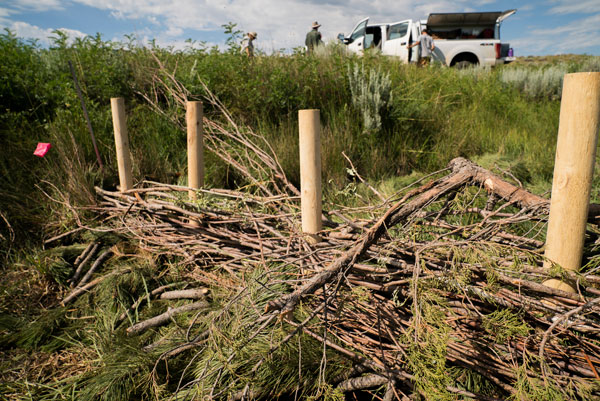 Plus, they are ideal for the kinds of public-private partnerships that support local interests and offer buy-in with state or federal resources.
Plus, they are ideal for the kinds of public-private partnerships that support local interests and offer buy-in with state or federal resources.
State and Federal agencies and their partners recognize the need to scale-up their restoration efforts. Isolated attempts to restore these natural processes will never have the watershed scale impacts necessary to increase long-term resilience across a landscape as large and diverse as Montana. But Shallcross and others believe in the benefits of low-tech solutions designed and planned by experts and implemented by small, trained crews that roam under the Big Sky. A BDA project is meant to kickstart the restoration process and is not a panacea for watershed scale restoration. Long-term solutions that build resilience and keep more water on the landscape will take time and a commitment to land management strategies that prioritize watershed health.
As another long, hot day on the prairie winds to a close, Joshua Powell and the Mesic Strike Team complete their final patches on the dam. Then they head up the stream channel about 100 yards to pound in poles and begin on another dam, busy as beavers.